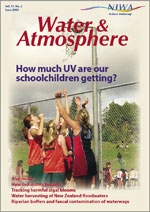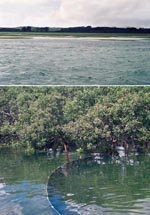PDF of this article (383 KB)

Update on NIWA survey of fish communities in mangroves and seagrass meadows

During March and April, NIWA completed large-scale sampling of mangrove fish communities in estuaries on both North Island coasts: Rangaunu, Mangawhai, Mahurangi, Waitemata, and Tauranga in the east, and Kaipara and Manukau in the west. New Zealand’s mangrove forests are advancing as estuary sedimentation rates have increased in recent decades, with intense debate on their ecological value, and how these fringing habitats should be managed (if at all). A common argument is their importance as fish-nursery habitats (as for tropical species), but there have been no quantitative data to test this claim until now.
While the samples have yet to be sorted and measured, we can already make some general observations. Fish abundances were relatively high, with the ubiquitous yellow-eyed mullet being the most numerous, along with many juvenile short-finned eels caught at night. Fish diversity was relatively modest; juvenile parore were a consistent feature of some east coast estuaries, juvenile grey mullet were patchily abundant in the two west coast estuaries, and the invasive bridled goby was present at several Mahurangi Harbour locations. We are also assessing the effects of environmental factors (water turbidity, dissolved oxygen, sediment nutrient, chlorophyll a), mangrove characteristics (tree density, height, juvenile understory), and landscape features (forest width, proximity to channel, other habitats, latitude). Using this new knowledge, resource managers and local communities will be able to engage in more objective debate on how to advance different mangrove management options.
Our limited sampling of Rangaunu Harbour’s subtidal seagrass meadows confirmed their high ecological value, with large catches of juvenile snapper in metre-deep water (400–500 fish per 50-m seine tow), along with numbers of spotties, goatfish, triple-fins, parore, and broad squid. A new three-year Ministry of Fisheries Biodiversity Fund programme will advance our understanding and management of biodiversity of seagrass habitats throughout New Zealand, including their role as invertebrate and fish nurseries, input into foodwebs, and overall contribution to maintaining ecosystem biodiversity.
For more about the project, see “Surveying fish in the mangroves and seagrass wilds of Northland”.
For further information, contact: Dr Mark Morrison, 0-9-375 2063, [email protected] or Dr Malcolm Francis, 0-4-386 0377x, [email protected]
